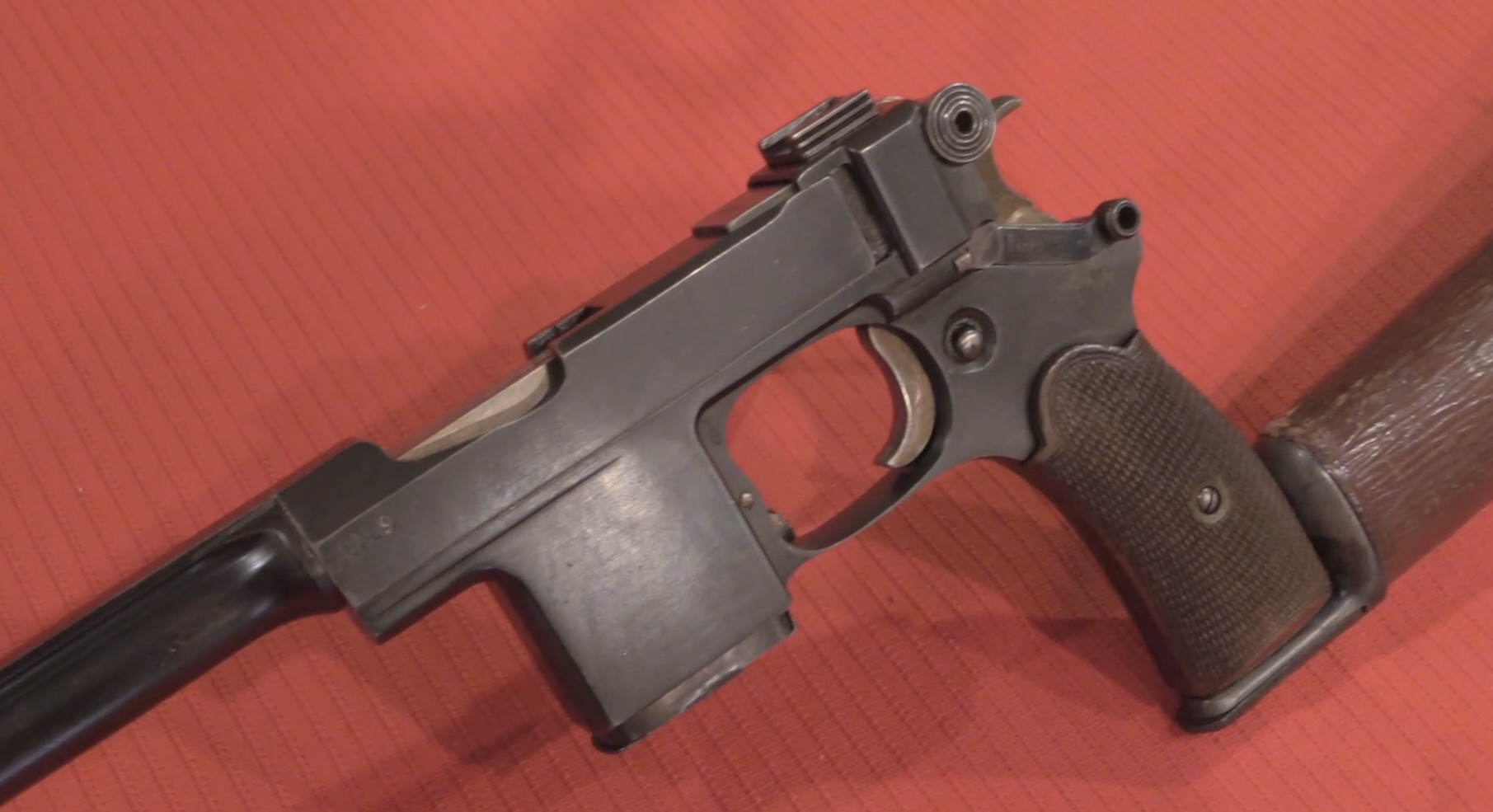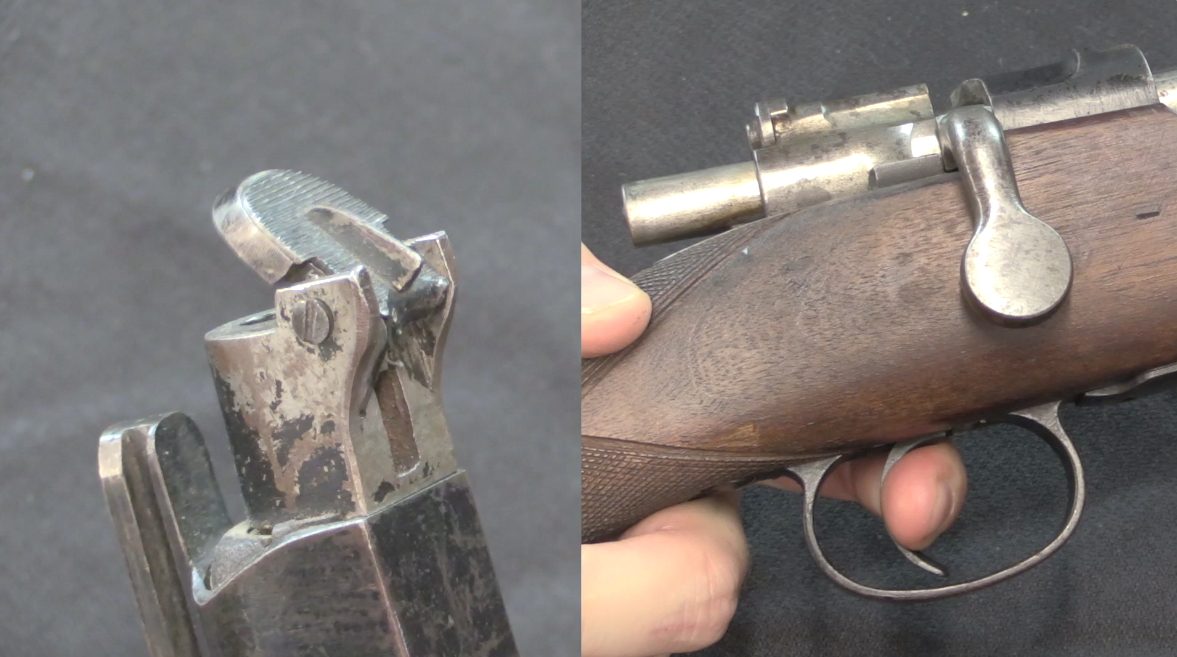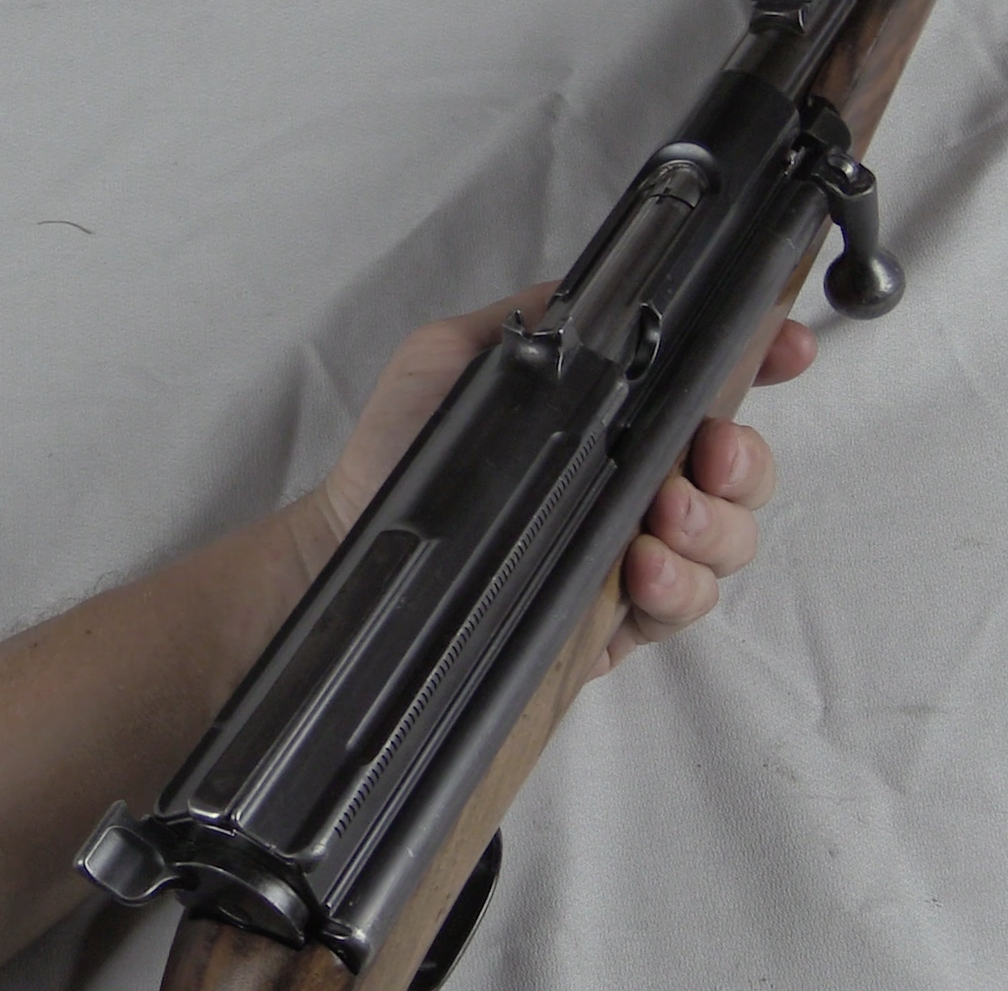In the 1930s, Portugal was looking to update its small arms, and wanted to get some top-shelf K98k Mausers to replace its 1904 Mauser-Vergueiros. The country was on good terms with Germany, and so Portugal placed an order for 100,000 K98k rifles in 7.92mm Mauser caliber from Mauser Oberndorf in 1937. The first 50,000 (designated m/937) were to be standard production just like the Wehrmacht used, and the other 50,000 (designated m/937A) were to include a few changes to elements like the front sight and sling swivels. All would have a Portuguese crest on the receiver and a 1937 date (although delivery trailed over into 1938), but all of the proof marks were standard Wehrmacht pattern.
These guns were all delivered, and Portugal was quite happy with them. A second contract for another 50,000 was placed in 1941, once again for the standard Germany military configuration. These were designated m/937B, and we are looking at one of those rifles today. In total, 60,000 were made, as 10,000 were requisitioned for German military use. The Portuguese Mausers are a neat time capsule because they show the standard of prewar and early-war Mauser production, and many survive in excellent condition since they sat essentially unused in Portugal instead of seeing combat.
It is worth mentioning that the roughly 10,000 examples seized by the German military have turned up basically everywhere Mausers went, including Russian captures and Norwegian F1 conversions.




“The country was on good terms with Germany” Well, yes, the Salazar government was fascist https://en.wikipedia.org/wiki/Ant%C3%B3nio_de_Oliveira_Salazar But Portugal had a close relationship with Britain going back centuries, fighting as a member of the Allies in WW1. And when Churchill stunned parliament when he invoked the Treaty of Windsor (1386) to occupy the Azores in 1943, Salazar responded favorably and at once. Apparently Salazar detested Hitler personally…https://en.wikipedia.org/wiki/Anglo-Portuguese_Alliance#Second_World_War
Yes. The “Estado Novo” of Antonio de Oliveira Salazar, followed by Marcelo Caetano after his fateful slip in the bathtub… For that reason, a lot of these Mausers were used in the Colonial War in Guinea-Bissau, Angola (an actual settlement colony of sorts under Salazar’s regime), and Mozambique, along with other German made arms like the “Dreyse” MG-13/ m/938 metralhadora, etc. Eventually the West German HK G-3 replaced the bolt-action service rifles.
https://www.youtube.com/watch?v=RPuxu1fG5sw
The Portuguese Estado Novo always rattled the Azores when the Kennedy government of the USA, or the more liberal Nato members like the Netherlands gave them problems for using equipment provided explicitly for Nato defense of Europe in the colonies… In fact, the entire armed forces in the 1960s was wholly turned over into COIN, only to be changed back again after 1974.
Apparently Salazar detested Hitler personally…
In 1939 Pacto Ibérico was signed https://en.wikipedia.org/wiki/Iberian_Pact
it provided neutrality of Spain against Portugal and neutrality of Portugal against Spain. This was manifestation of Portugal and Spain to stay out of European war. In such situation, even though some islands were seized yelling at Great Britain might be seen as too dangerous.
After Barbarossa, and the German military/industrial institution is STILL in a position to accept substantial export agreements with neutral countries.
For comparison, I’m reading William L Shirer’s ‘Collapse of the Third Republic,’ and it seems France was actually EXPORTING tanks and anti-tank guns during the ‘phony war.’
“(…)was actually EXPORTING tanks(…)”
Well, if you compare tanks by number in 1940 French have more
https://en.wikipedia.org/wiki/Battle_of_France
gives 2445 against 3,383…4,071, so they might allow to sold some which would provide money needed to buy more needed types of weapon, note for example they bought many foreign made aeroplanes, for example Glenn Martin 167 A-3 https://en.wikipedia.org/wiki/Martin_Maryland#French_service
The reason everybody was exporting armaments was very simple but twofold
1) try to gain allies by supporting them with weapons
2) every exporting nation needed money for the next war.
Could not Spain supply essentially the same rifle from LaCoruna arsenal? From right next door>?
I’m laughing
The Portuguese state buy arms from the Spanish state?
It’s almost like the Scottish, Welsh and Irish Nationalists thanking England for anything more than being there to hate and blame for all of their own short comings.
It’s never going to happen
I whole heartily agree! Portugal and Spain have had issues throughout their history!
Spain was a bit busy with its own civil war by 1937 until 1939.
Gwyn
“Could not Spain supply essentially the same rifle from LaCoruna arsenal?(…)”
But they used 7×57 whilst Portugal apparently need rifles in 7,9 x 57 cartridge. Also if I understand correctly https://en.wikipedia.org/wiki/Mauser_Model_1893#Variants they produces design approved yet during Great War, whilst Portugal apparently wanted spanking new version. Finally I do not know if license agreement allowed Spanish to produce Mauser rifles for foreign contractor.
The licence conditions angle is interesting.
What was the situation after ww1?
Brno was manufacturing mouser 98s, but advancing with different metallurgy, for example through hardening rather than case hardened steels
And Brno won a contract to make rifles for Persia, against Oberndorf
“for example through hardening rather than case hardened steels”
——-
WHAT?
To make a hand grenade out of it? Certainly not. The typical process for barrel is Normalizing (increasing toughness). Much the same for receiver, although the case hardening is ok as long as it does not cause distortion.
“(…)mouser 98s(…)”
Disclaimer: I assume this is derogatory moniker for Gewehr 98, if this does not hold true ignore this post enitrely.
“Brno was manufacturing(…)”
According to http://www.vhu.cz/puska-vz-24/ Czechoslovakia just used opportunity caused by treaties following Great War, which prevent Germany from production military weapons
Tvrdé podmínky versailleské smlouvy zakazovaly Německu mimo jiné výrobu vojenských zbraní, což umožnilo čs. vládě reagovat na nabídku německé zbrojovky z 18. října 1919, obsahující odprodej strojního zařízení k denní výrobě 300 armádních pušek systému Mauser za cenu 3 141 292 marek.
Thus in 1919 they produced machines allowing crafting 300 examples of Mauser per day for 3 141 292 Mark.
So I assume they were negotiating when Germany was verboten from producing military fire-arms, therefore do not have motivation from preventing sales of Czechoslovak-made weapon to foreign customer, as they were not production them, so no competition could arise.
After the end of WWI, the newly formed Csl. Army had variety of foreign rifles among them Mannlicher, Mosin and Lebel. Some were from former Empire armories and some brought home from abroad in hands of Legions. They needed to outfit their new military with new unified rifle as a first priority. The export came later as a secondary endeavor. The choice fell logically on the best rifle of the time.
The purchase of Mauser production line also spawned contact with designer Josef Nickel which led to introduction of new Czech domestic military issue pistol – the vz.24. Thus both the rifle and pistol had same designation, much like later after the war with the vz.52 combo.
The Spanish Army decided to adopt 7,9×57 as their new standard rifle and machine gun after the Civil War due to the numbers of rifles Franco got from their German allies and the large quantities of Polish and Czech Mausers of wz.29 and vz.24 captured/inherited from their Republican foes.
The Portuguese “colonies” were considered to be Portugal
For example, the Portuguese monarch was based in Brazil for a number of years.
Angola was settled from Brazil, and the culture is more Brazilian than strictly Portuguese.
There was an independence movement in Angola, and a portaguese former colleague’s father spent part of his national service there during that period.
Actual independence for the colonies remaining into the 1970s turned out to be de facto
The 1974 revolution happened in Portugal, and that was it
Whether Angola or Mozambique would have had their long civil wars without outside interference… that’s a very difficult question.
It was interesting during the England vs Portugal World Cup match in 06
The Angolans were cheering for Portugal because Portugal had been the colonial power until 1974
The Irish were cheering for Portugal because England had been the colonial power until 1916…
Difficult questions
Incidentally, there were some very interesting multi bore volley guns in the big Fort museum in Luanda, along with lots of bronze cannon lying around where the termites had eaten the wooden carriages.
I don’t recall seeing any nice k98s, veguiros or Guedes single shots either
Most of the guns in use by cops and security guards were AKs, Toks, makarovs, and some vz58s, along with a few Taurus revolvers.
Hey Ian, what about telling us which cartridge was chambered in this rifle and what the Portuguese preference was? During all the chatting I was listening out for that as the first thing when I see a rifle I want to know what calibre bullet does it shoot and from what type case?
The comments focuses on international politics but there is a more interesting subject of cartridge selection by the various countries using the Mauser 98.
Standard 8x57mm Mauser.
Aha, here is the reason why not purchased from Spain (in 7x57mm) part of political reasons, as Keith has stated.
Looking at Rui’s remark I realize I may be in error. Yes, there were also other reasons for Spanish rifle caliber change. Thanks Rui!
You are welcome, Denny! The La Coruña arsenal actually started to churn out their own copy of the Kar98K/vz-24 after 1943 and a version modelled after the Polish wz.29 for the Spanish Ejército del Aire from 1944 onwards.
Note that unlike other European nations using 6,5 mm rifle cartridges in 1930s, Portugal apparently decided to change to cartridge better suited for machine gun use but also acceptable in rifles, rather than having cartridge for rifles and different cartridge for medium machine gun (like Swedish 8×63 patron m/32 or Italian 8×59 or Norwegian 7,9×61)
http://cartridgecollector.net/792-x-61-norwegian-mg
By the early 30s, Portugal actually had two main rifle cartridges in use, the 6,5 Vergueiro but also .303 Brit, introduced after the CEP ‘adventure’ on the Western Front during WWI. The British cartridge was actually considered for general adoption in the late 1920s/early 1930s.